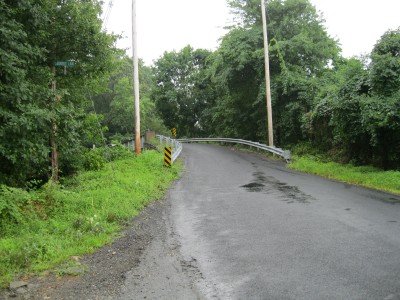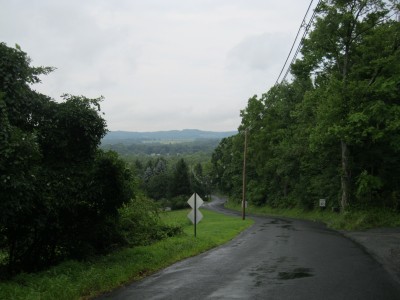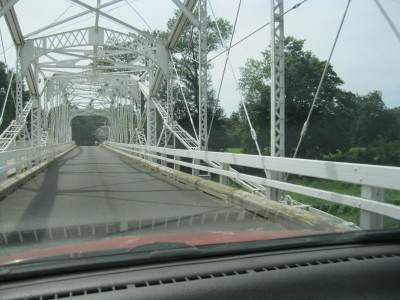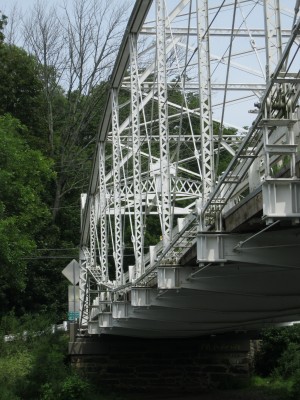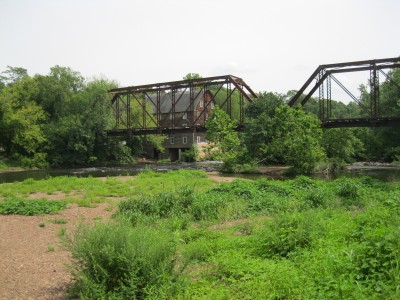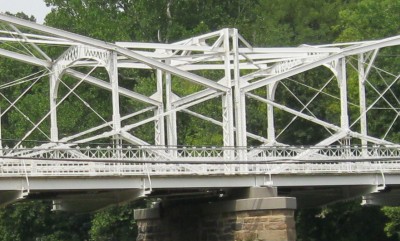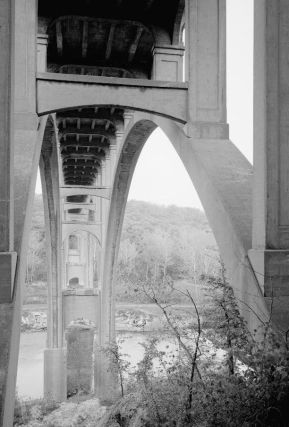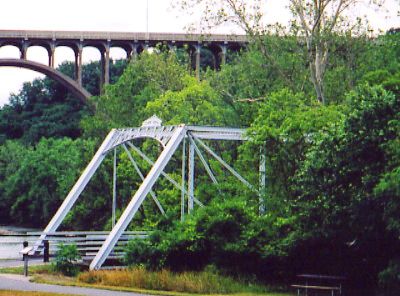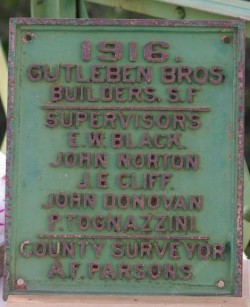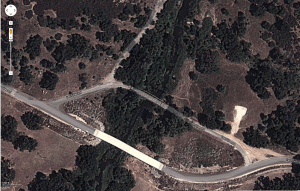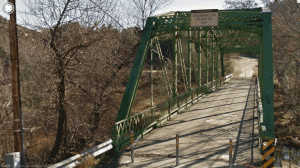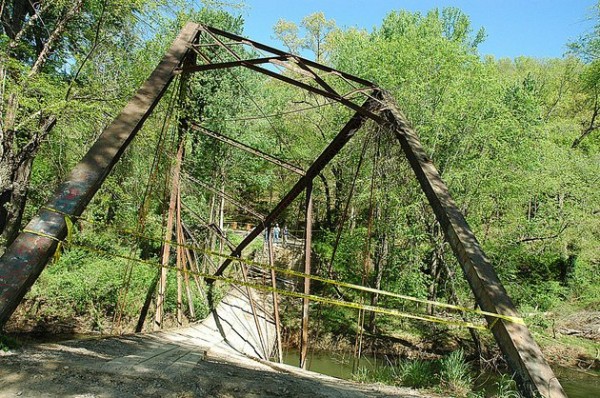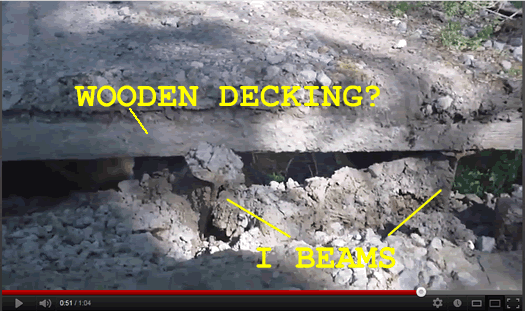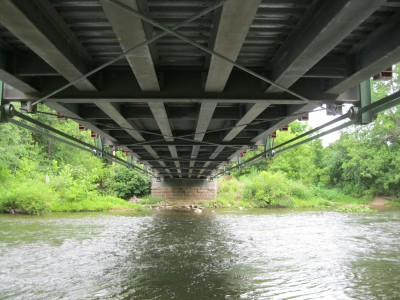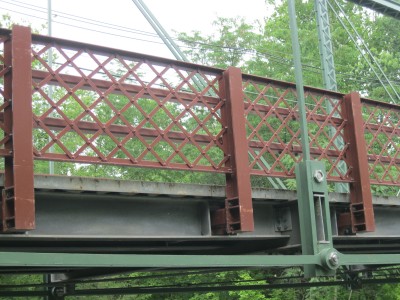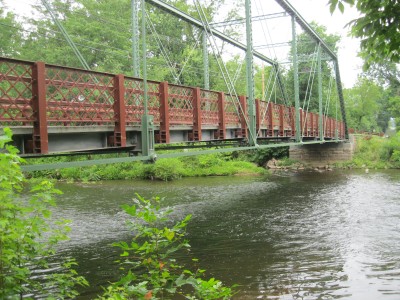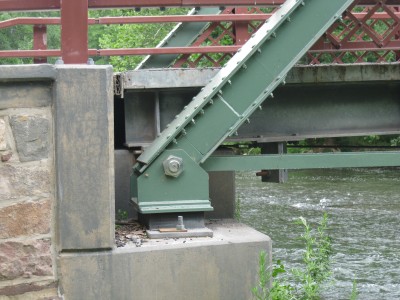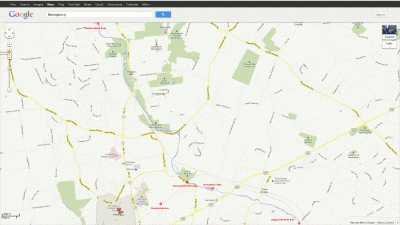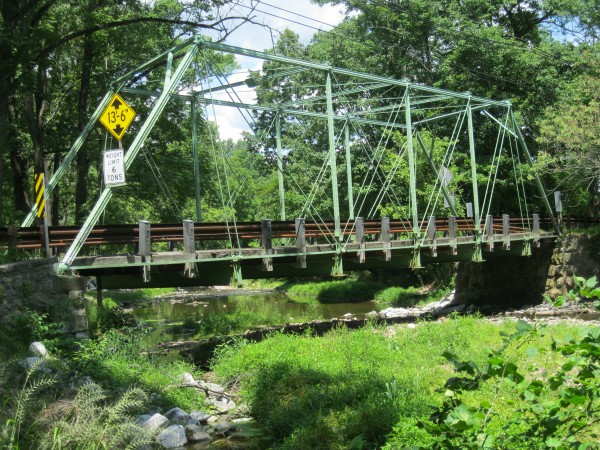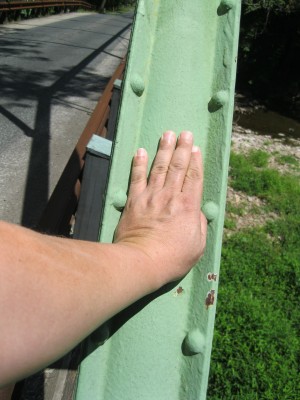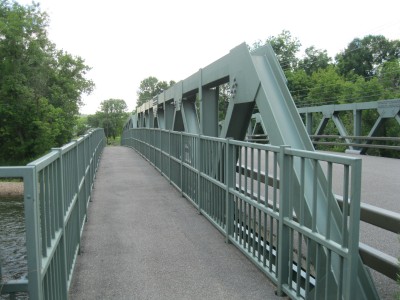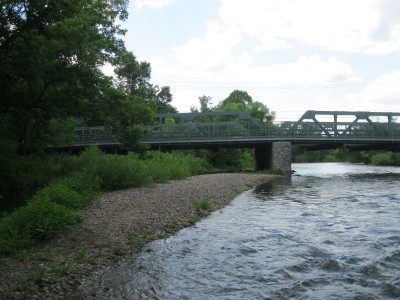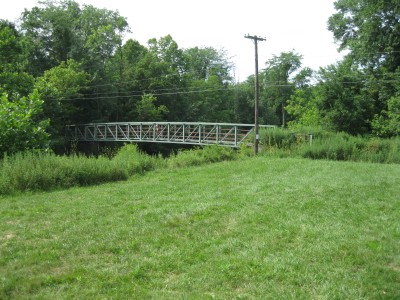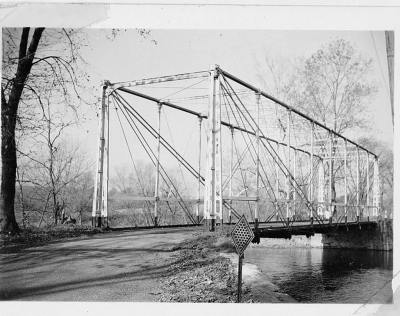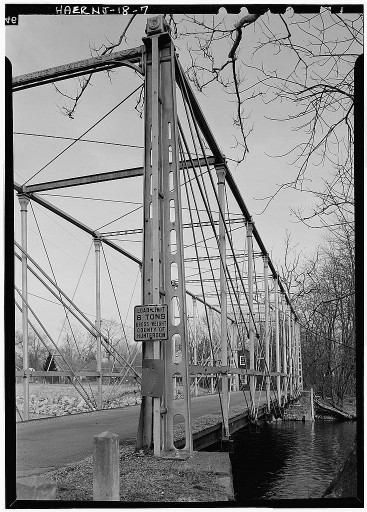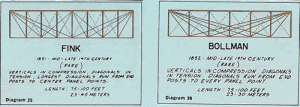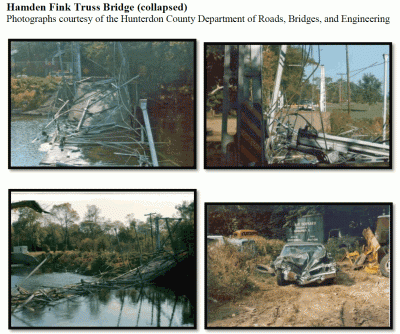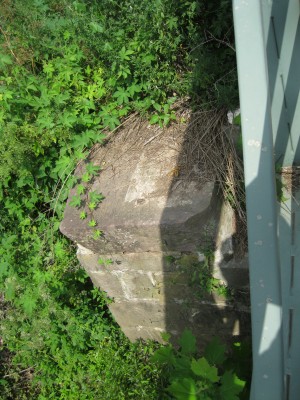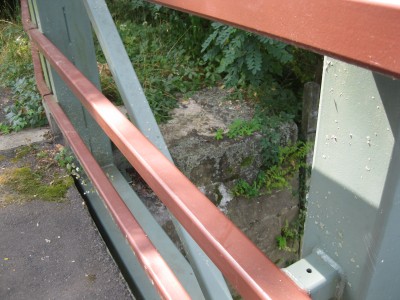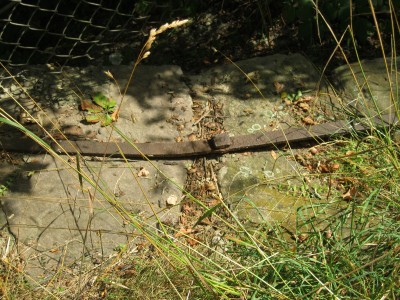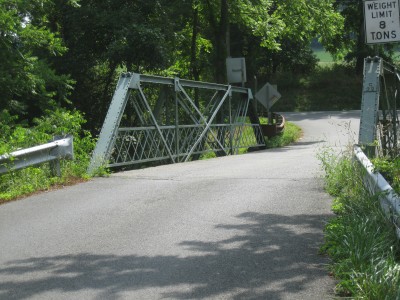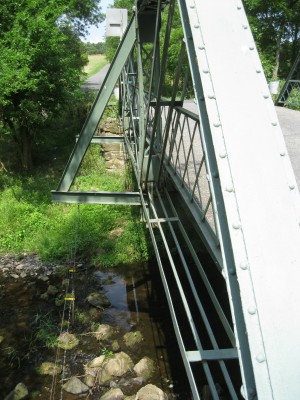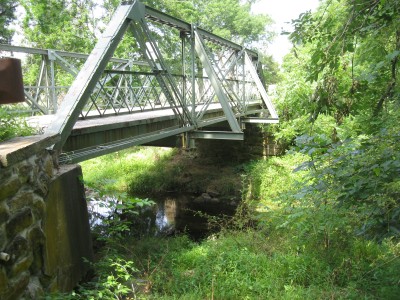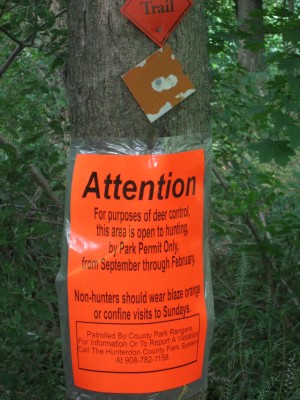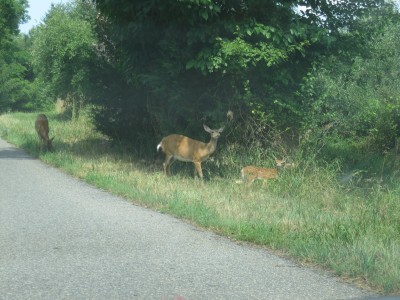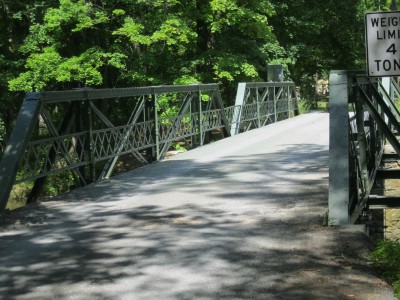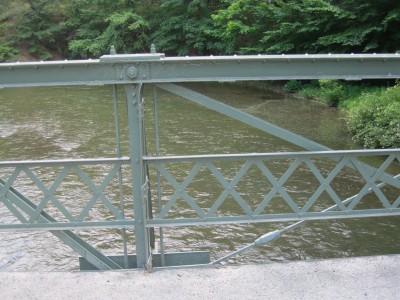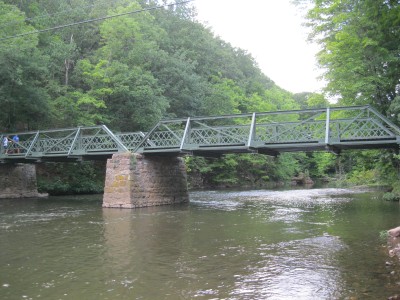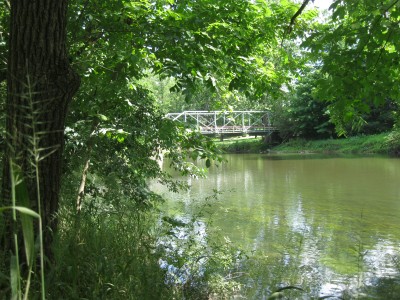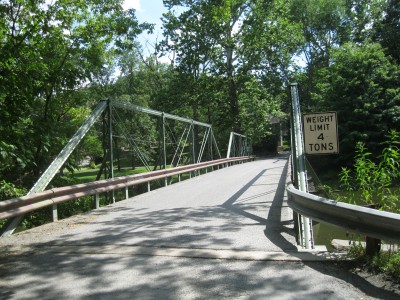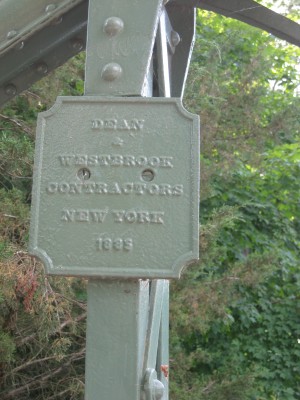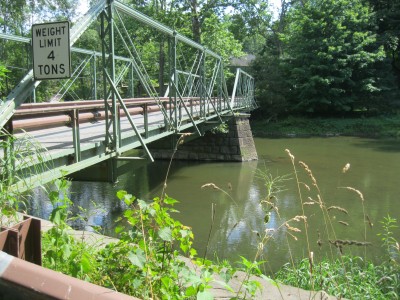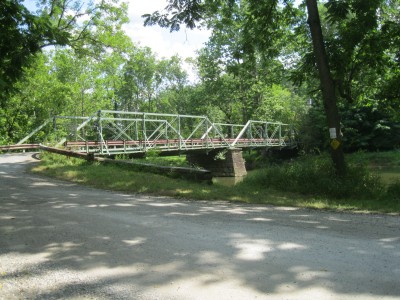 Tuesday - August 14, 2012
Tuesday - August 14, 2012
local fame
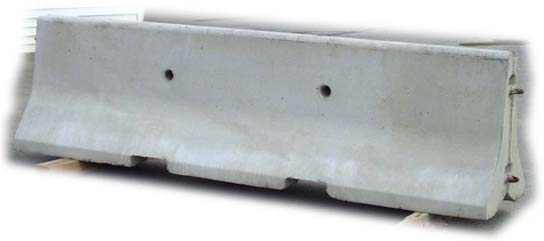
You see these things everywhere out on the roads. Any place there is road work. Any place the road crews are widening a lane, repaving a bit of highway, whatever. I gather that these portable concrete short protective walls are called Jersey Barriers everywhere on the planet ... except in New Jersey. We just call them “those concrete things in the road”. Which is funny, because they’re from here actually. My own very local part of from here, actually.
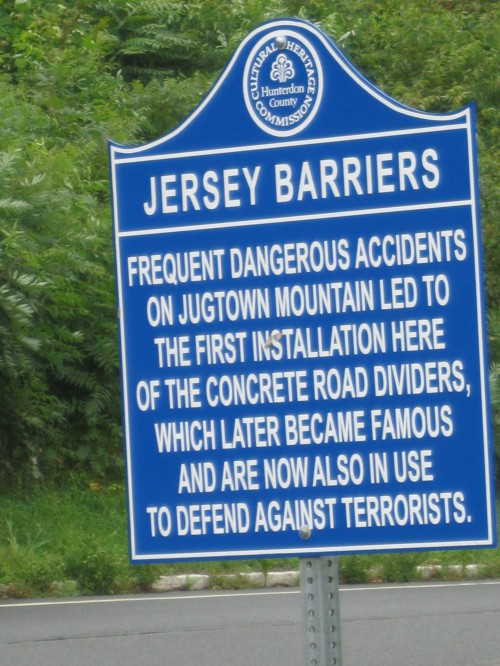
Small claim to fame, I know. But like the great Jersey Divide, those little blue road signs always give you a bit of local history.
And if there ever was an area where crash-proof lane dividers really needed inventing, this is it.
I was coming down Iron Bridge Road this afternoon ... there is no iron bridge there any longer; that old bit of 1850s iron was long ago replaced and these days there is a galvanized steel girder bridge with wood planking there instead, turned 45 degrees to the road and with a blind drop off ...
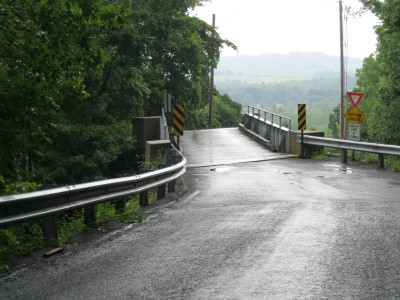
... and I’m riding the brakes hard the whole length of the road. Trust me, I’m not a ninny behind the wheel, or afraid to go fast or to corner hard. But the roads out here seem vertical. I’ve gone on milder ski slopes that were marked with black diamonds. Plus the lanes are very narrow, and dark under the trees, and they quickly turn to the left and right. Blindly turn I should say. You know it starts being a challenging drive when the signs say “blind corners next 4 miles”, but it really gets the driving challenge on when the signs say “extremely steep road ahead drive at your own risk” ... and that’s where Jersey Barriers were born. In the steepest and blindest roads in the state. Right here in Hunterdon County, not 5 miles from where we live. In the mountains, almost. Well, almost in what passes for mountains in New Jersey. There are two of them I think, in the whole state. And they aren’t really all that tall. Just vertical on the sides.
Personally, I prefer the taller “Ontario barriers”, “F barriers” or whatever they’re called. They do stop bigger trucks better, but I like them best because they block the headlights from even the tallest pickups and SUVs coming the other way and I don’t get blinded in my low to the ground little skateboard Saturn.
Posted by Drew458
Filed Under: • Bridges • Miscellaneous •
• Comments (5)
 Friday - August 10, 2012
Friday - August 10, 2012
still not dead
Still not dead. Not posting much. Online a whole lot less.
Looking for work.
Still not smoking. Not even using an unlit cigar as a chew toy at this point.
Doing a little bit of bridge hunting; very happy to report that All Is Right With That World: A) not only are there Parker truss bridges in Somerset, the next county over; B) I’ve found yet another phoenix column bridge along the South Branch. Ok, this one is actually along the Raritan Water Power Canal, a strange bit of capitalist history in itself, and was put there for scenic effect after being a working bridge in two previous locations. But the Power Canal is only a couple hundred yards in from where the South Branch and the North Branch come together; C) (and the real cause of my happiness) truss bridges are still being built in Hunterdon and Somerset Counties. Ok, they aren’t the big massive works of the middle 20th century. And they aren’t the flyweight fairy bridges of the late 19th century. But they have a peculiar modern beauty all their own that I’m learning to love. And they’re all twin span pony trusses, which fit in perfectly with the other bridges in the area.
No big pictures today.
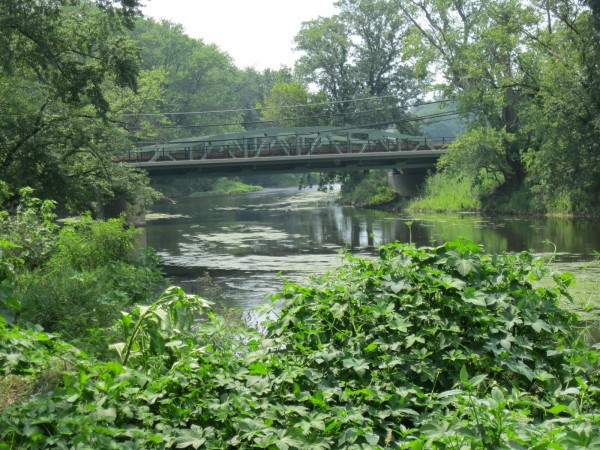
The Studdiford Drive “Camel Warren”. A twin span camelback half subdivided Warren pony bridge. This is about 3 miles up the road from the lenticular bridge I posted on the other day, with 2 other interesting bridges in between them.
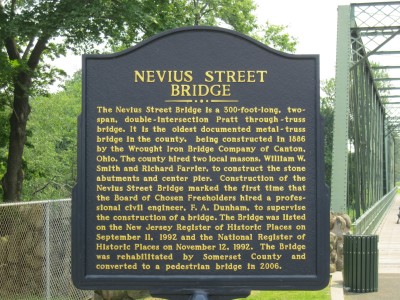
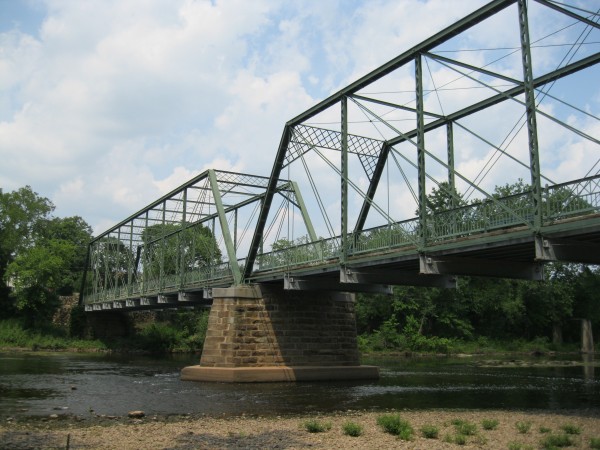
At the eastern end of the Raritan Water Power Canal is this nice old bridge, now restored and open only for foot traffic. The sign calls it a “double intersection Pratt” which is another way of saying it’s a Whipple truss. Pretty darn rare, although once common for railroad bridges. Twin span, but a through truss not a pony. Same kind of bridge as the under bridge in that domestic terrorism post the week before.
This “last” bridge in my two part walkabout is about 4 miles east of the Studdiford Drive bridge, with “only” the phoenix column between them. Another 2 miles to the east are a few Parker railroad bridges and a possibly interesting foot bridge to nowhere. But hey; D) Parkers!!!! Woo hoo!!! It was Parkers that got me started on this whole summer of bridge learning.
And yeah, there’s a double Warren a few miles to the north of me in Belvedere. Same kind as the bridge down south in Washington’s Crossing. And if I visited that one, I’d have to stop at the other phoenix column bridge down in Stockton. Hoo boy, imagine that, 4 separate phoenix column bridges in a 20 mile radius from where I live. Plus cast iron Pratts, all sorts of old pinned trusses, riveted trusses, a modern camelback, a lenticular, a Fink in a warehouse somewhere, and some genuine Parkers. As a bridge spotter, I am spoiled for riches without ever using more than a gallon or two of gas. Sweet.
Posted by Drew458
Filed Under: • Bridges • Daily Life •
• Comments (5)
 Wednesday - August 08, 2012
Wednesday - August 08, 2012
Teaser
Another bridge post. All pictures linked to much bigger versions.
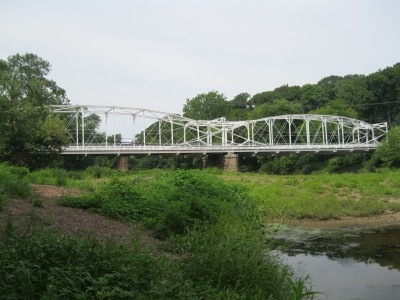
One of the more rare early truss bridges is the one called the lenticular truss. It looks like a lens, a discus, or a UFO. It is very strong design, combining the strengths of both the arch and the suspension bridge in one. It also has a tendency to bounce like the set of carriage springs it resembles, so the popularity of this kind of truss waned pretty quickly when it turned out that the rapidly moving public wanted bridges that did more than merely not collapse; they wanted them to SIT STILL while they were being crossed. Sorry Charlie.
Only about 40 of these bridges remain in the USA. Only about half of those are still in use for vehicular traffic. And most of the ones still in use turn out to have been made by the Berlin Iron Bridge Company of New Berlin Connecticut. How about that? Pretty darned good work record, considering most of these old girls are nearly 120 years old now. You can find them from New England down to Texas, with a good number across upstate New York and another bunch scattered across Pennsylvania. New Jersey has two, so OF COURSE one of those is near where I live, and in pretty darned amazing great shape, open to regular vehicular traffic, albeit rather weight limited traffic. And where else would it be, but on the South Branch, our local little river that seems to have more antique truss bridges across it per mile in it’s 10 mile length than any other river in the country.
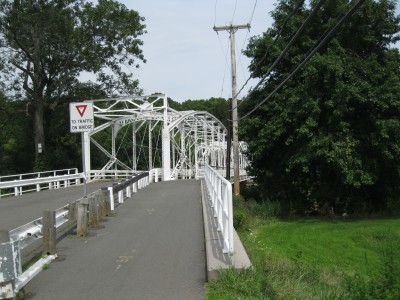
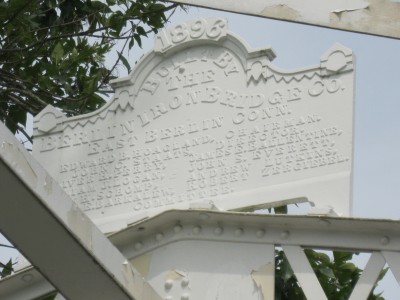
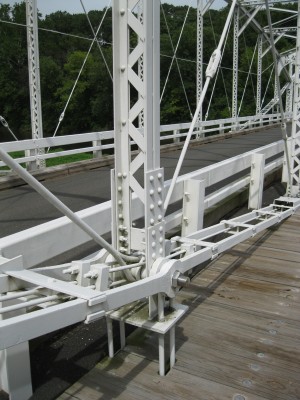
I have a ton more pictures naturally. This is the Elm Street Bridge in Neshanic Station NJ, just over the county line into Somerset County, and is about 2 miles downstream on the South Branch of the Raritan River from the Higgensville Rd bridges in Three Bridges NJ, which are in turn about 1 mile downstream from the Rockafellows Mills bridge I last posted about.
Those nuts on those nice new shiny stainless steel pins - the Elm Street bridge is well taken care of, and is yet another example of the “rare” pin connected truss (rare everywhere but Hunterdon and Somerset Counties NJ) - are about the size of the palm of your hand. This bridge is two spans across, each span is about 140 feet.
Posted by Drew458
Filed Under: • Bridges •
• Comments (0)
 Thursday - July 26, 2012
Thursday - July 26, 2012
Bridge Haters
Meant to post this yesterday but family issues got in the way. As usual.
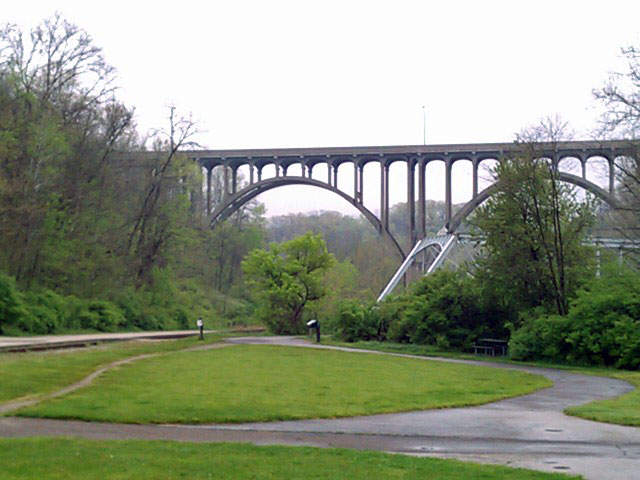

AKRON, Ohio - One of five men charged with plotting to bomb an Ohio highway bridge pleaded guilty Wednesday and agreed to testify against his co-defendants.
Anthony Hayne, 35, of Cleveland, who has a criminal record for theft and breaking and entering, pleaded to all three counts against him in U.S. District Court. His attorney, Michael O’Shea, said Hayne hopes to get leniency in return for his testimony.
Under the terms of the surprise plea deal, Hayne will have the chance to avoid a life prison term. With the plea and offer of testimony for the prosecution, he could face 15 years to nearly 20 years in prison.
“I don’t think any of these guys intended harm to human beings,” O’Shea said. “I think they just thought this was a way of making some sort of political statement. But I’m relatively confident none of these people had any desires to actually hurt anybody.”
O’Shea said Hayne was a latecomer to the alleged plot and, as such, had the least standing to argue that he had been manipulated by an FBI informant as other defendants have contended.
Authorities have called the men anarchists, and investigators say the group planted what turned out to be a dud bomb provided by an FBI undercover informant on a bridge south of Cleveland and then tried to detonate it.
The defendants could face life in prison if convicted.
U.S. Attorney Steven M. Dettelbach said the government would now turn its attention to proving the case against the other four men. “We are pleased with today’s guilty plea and are prepared to prove the allegations against the remaining defendants,” he said in an emailed comment.
The five were charged with plotting to bomb a bridge linking two wealthy Cleveland suburbs by placing what they thought were real explosives at the site and repeatedly trying to detonate them using text messages from cellphones, according to the FBI affidavit.
The FBI said the suspects bought the explosives - actually fake - from an undercover employee and put them at the base of a highway bridge over the Cuyahoga Valley National Park, about 15 miles south of downtown Cleveland.
After leaving the park, they tried to initiate the explosives using a text-message detonation code, and they called the person who provided the bombs to check the code when it failed, according to the FBI affidavit.
The men also discussed other potential targets, including a law enforcement center, oil wells, a cargo ship or the opening of a new downtown casino, according to a prosecution affidavit.
The five had been associated with Occupy Cleveland, but organizers of the movement have tried to distance the group from the men. They say the five didn’t represent it or its nonviolent philosophy.
Yeah right, the Occupy Movement’s nonviolent philosophy. CYA much? You think we’ve forgotten the Occu-Mess already? The beatings, rapes, robberies, public defecations ... the desire for anarchy. And now their anarchists have been caught. And if this Loserama bunch of pond scum rejects had got their hands on real explosives, or found somebody with the smarts to create his own, we’d be out at least one nice bridge by now. Maybe two, depending on the size of the blast and the collapse. And I’m not buying the “we didn’t mean or intend to hurt anybody.” Bullshit. The bridge is used by thousands of people every day. No matter when they pushed their detonate button, there was likely someone on the bridge. Had their bomb been real and gone off, that would have been murder.
Life in prison is too good for this crew. Hang ‘em.
[ Back in May 2012: ] CLEVELAND (AP) - After unknowingly working with an FBI informant for months, five men have been charged with plotting to bomb an Ohio bridge linking two wealthy Cleveland suburbs.
Federal authorities Tuesday described the men as anarchists who are angry with corporate America and the government. They say the alleged plotters researched explosives and obtained what they thought was C-4 explosives. The material, in fact, was harmless and the public was never at risk because the men got it from the informant, officials said.
Their arrests Monday night marked the latest case in which FBI agents planned fake terrorism plots alongside targeted suspects, an indication it continues to be a top strategy for the government in preventing terrorism.
“They talked about making a statement against corporate America and the government as some of the motivations for their actions,” U.S. Attorney Steven Dettelbach said in announcing the arrests with the head of the FBI in Cleveland, Stephen Anthony.
Court documents detail several conversations the FBI secretly recorded in which its informant discussed the bomb plans with some of the suspects.
In one, Brandon L. Baxter, 20, of Lakewood, allegedly said “Taking out a bridge in the business district would cost the ... corporate big wigs a lot of money” because it would cause structural damage and prevent people from going to work.
He and another suspect, Douglas L. Wright, 26, of Indianapolis, favored targeting a bridge because it would limit “the number of casualties and the potential for killing possible supporters,” court documents said.
I know what you’re thinking, and I have the answers you want ...
Posted by Drew458
Filed Under: • Bridges • Terrorists •
• Comments (5)
 Tuesday - July 17, 2012
Tuesday - July 17, 2012
Tenacious As A Terrier
Oh boy! Yay me! I’m doing the happy dance here.
(all pictures link to much larger versions)
It took me just over a week to locate the bridge I’d seen on TV and posted about here. The one I’d seen on the final episode of the TV show House. Man what a bunch of work it’s been. But I’m 100% certain I’ve got the right one. Not only does it match in style, size, color, and location, it’s right around the proper age. Best yet, recent photos of the bridge match what I saw on TV right down to the Rustoleum™ marks, the turnbuckles, the surrounding trees ... it’s a perfect match. SCORE !!!
What I Saw On TV:
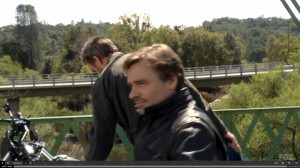
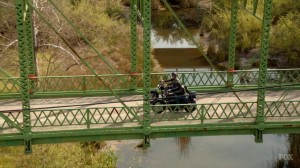
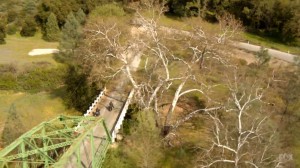
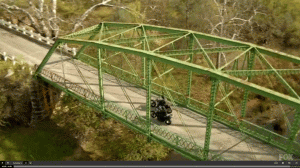
What I Found Online
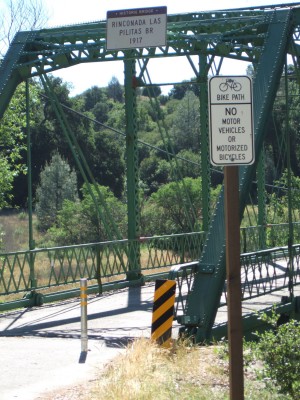
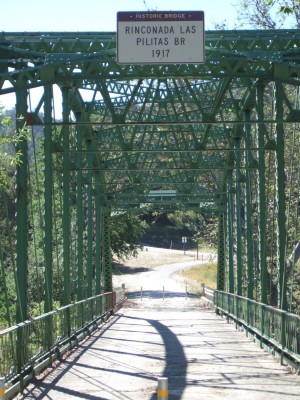
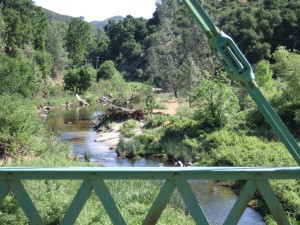
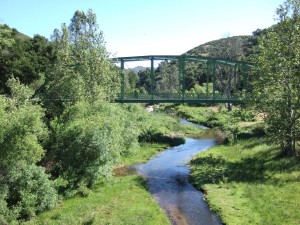
So what and where is this thing? It is the Rinconada Las Pilitas Bridge, a pinned Parker truss bridge built in 1917 by the Gutleben Brothers bridge company of San Francisco. The bridge is located in San Luis Obispo County California. It crosses the Salinas River about a mile northwest of Santa Margarita Lake. The bridge underwent a bit of restoration and got a new paint job in 1996. Since a new concrete bridge was built just 150 feet away, the old Parker is no longer open to car traffic and is reserved for hikers and bikers. And the occasional TV show motorcycle it seems.
decimal lat/long: 35.348784,-120.513052
Status: Closed to vehicles, roadway has been realigned with new bridge
History: Built 1917
Builder: Austin F. Parsons (County Engineer Designer)
Design: Pratt Through truss
Dimensions
Length of largest span: 149.9 ft.
Total length: 231.0 ft.
Deck width: 15.4 ft.
Vertical clearance above deck: 13.9 ft.
Recognition: Eligible for the National Register of Historic Places
Also called: Rinconada Las Pilitas Bridge
“Las Pilitas Road is only one lane wide and climbs over a rocky spur. The land turns distinctly drier and there are signs of recent bush fires. After reaching a crest the road then descends quickly to reach the Salinas River ... containing the outflow from Santa Margarita Lake. Crossing the river is an elegant metal lattice bridge constructed in 1917. The bridge is now reserved for cyclists and walkers ... vehicles use a new concrete bridge some 50 meters upstream.”
There does seem to be a little confusion on when the thing was built and by whom, which is not unusual for bridges this old
The Salinas River Bridge was formerly identified as Bridge No. 49-106. It was designed by San Luis Obispo County Surveyor A. F. Parsons and constructed by the Henderson Bridge Company in 1914. A bridge rating sheet completed in 1985 as part of Caltrans statewide Historic Bridge Inventory described it as an “excellent example of its type in its region, and [it] has served as a locally important crossing of the Salinas River for more than seventy years.”
Parsons seems to have worn several hats at the county government, but I doubt he was a bridge designer. He may have specified a bridge of a certain size and type, but that’s about it. And it’s still standing 96 years later, so it seems he chose well. Somewhere I read that WWI got in the way, and work on the bridge was halted until the war was nearly over. That could just be rumor, although during the war there was such a steel shortage that ships were made out of concrete.
The first “official” public road coming into Las Pilitas canyon was surveyed in 1886 by then county surveyor E. Carpenter. This dirt road forded the Salinas River at a crossing very close to the spot where the present new million dollar concrete bridge exists today.
This road was officially called the “Rinconada and Pilitas Public Road”. ... The Salinas River crossing proved to be hazardous due to a soft channel bottom and high water during winter. So, in 1898 a group of early resident pioneers petitioned the board of supervisors for a new road with a better crossing location farther upstream where the riverbed was rocky. ... The second road (1898) was surveyed by then county surveyor V. H. Woods. This road was proposed as a 60 foot wide dirt road, and the new crossing was an apparent improvement. Then, in 1916 plans were made to bridge the river for year-around access, and a steel bridge was designed and engineered by then county surveyor Austin Frank Parsons ... In 1916, along with the steel bridge, Parsons also surveyed a new (third) road on higher ground and westerly of the previous two roads. This is the present road today (2010).
...
In 2006, the present poured concrete bridge was built at a cost of over one million dollars. The funds came from a federal bridge grant established only for really old bridge replacements. When the county received the grant funds, they then wanted to use the money for other bridge replacements that they considered more urgent, but the Las Pilitas had the only bridge that met the grant requirements, and so we got our new bridge.
Several things made it quite difficult to locate. While there is a National Register of Historic Places, the database is very hard to use, and worthless if you don’t already know the name or location of what you’re searching for. Your tax dollars at work! I searched through hundreds of Parker truss bridges at the various bridge web sites, like bridgehunter.com. No luck. Finally I tried looking for some kind of national bridge registry. There is not a government one, but I did find http://nationalbridges.com/ . Cool. Knowing that House was filmed in LA, I plugged in CA for the state, chose “Through Truss” as the bridge type, “steel” as the material, and guessed a Status of “Structurally Deficient” because the bridge I was looking for was around 100 years old. Back came the results, lots of them. So I sorted them by descending size, knowing that the House bridge was at least 120 feet long, and then went down the result looking for old ones. “Salinas River” was the 5th entry, so I opened up a Google tab and searched for “Salinas River Bridge”. Las Pilitas was the first hit, and for images ... the first one shown was a Parker. I had a feeling right then that it was Happy Dance time, but it took opening a number of the other resultant web pages to find my ultimate jackpot: pictures taken this spring of the bridge showing the same Rustoleum™ spray marks on the green paint. Woo hoo!!! Pure. Adrenaline.
Then I went back to bridgehunter and found that they had listed the bridge as a Pratt truss, and didn’t have any pictures. That isn’t exactly wrong, because this is a Pratt truss bridge. One with polygonal top chords ... which makes it a PARKER.
Grrrr. ![]()
Posted by Drew458
Filed Under: • Bridges •
• Comments (1)
 Saturday - July 14, 2012
Saturday - July 14, 2012
Double Secret Zombie Engineering
Another one of my local bridge spotting posts. The Rockafellows Mills Bridge is a Pratt through truss, built in 1900. It’s only 3 miles away from the bunch of local bridges I wrote about the other day. Click any of the pictures for much larger versions.
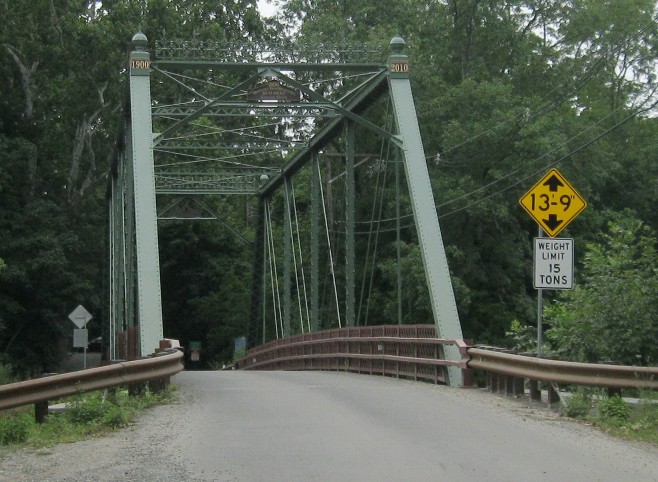
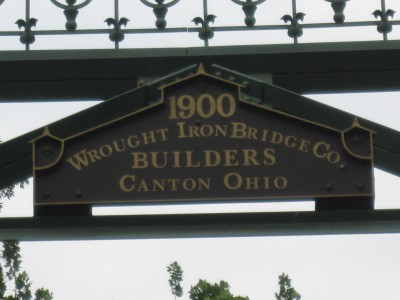
At the turn of the 20th Century, the Wrought Iron Bridge Company of Canton Ohio was going gangbusters. There were building bridges everywhere across America. They had developed a line of cost effective and reliable steel bridges that were easy to assemble and maintain, and towns and states were lining up to give them business. There wasn’t much of any truck or car traffic in those days; the world still ran on horses. But what there was, was thousands of poorly made, rotting, old wooden bridges nearing the end of their useful lives. And it was the Iron Era, so it was time for the wood ones to go.
Hunterdon County NJ bought several bridges from these guys. We still have most of them. The Rockafellows Mills bridge above is practically a kit bridge. It’s 140 feet across and about 18 feet wide. It’s a one lane job, and could handle a 3 ton load. It was put together with pins and rivets: no welding. It was the “Chevy Malibu” of it’s day: plus or minus some decoration, this bridge had hundreds of sisters all across the country. Here’s pretty much the exact same bridge in Arkansas:
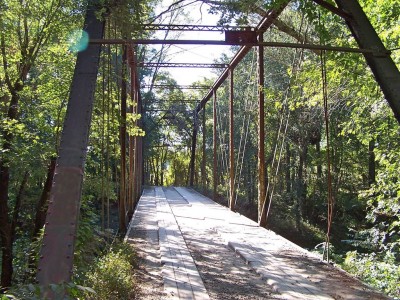
So what’s the big deal? Their bridge is dead. Ours is in glowing health.
And double secret zombie engineering is going to keep it that way.
Ok Drew, WTFF is “double secret zombie engineering”? It’s a special hitherto unknown bridge builder’s term that I just invented, that describes the hidden art of shifting the load from the dead to the live. Get a load of that.
More below the fold, including a redneck Pratt-fall.
Posted by Drew458
Filed Under: • Bridges •
• Comments (2)
 Wednesday - July 11, 2012
Wednesday - July 11, 2012
A Target Rich Environment
The MIL’s health situation got too stressful for me, so I went hunting. With a camera. Bridge Hunting. Boy did I score.
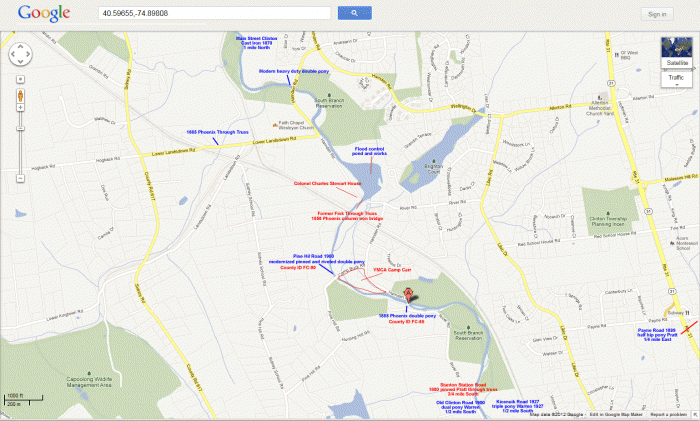
I am very fortunate to live in an area positively saturated with historic bridges. They’re everywhere, but you’ll never see one if you only stick to the major roads. You have to go a few blocks back, at which point almost all of the county becomes really rural and the calendar seems to rewind about a century or so. I figured out why these old chunks of metal have lived so long too: they are all in a pocket neighborhood, a north-south rectangle that has always had bypass routes on either side. You can get between Clinton and Interstate Route 78 (just north of this map) and Flemington and Route 202/206 by taking the back when down the west side of this zone on county roads and, or you can make the trip using local highway Route 31 to the east. So there is no real reason to go into that neighborhood unless you live there. And if you do live there, heavy trucks can get in and out using both those paths; they never have to pass over any of these antique ironworks.
I’ve written about a few of the bridges around here before, and with the “House” bridge post the other day you were reminded that it’s one of my interests. Well, the weather has been bearable the past two days, and I really, really needed to get away for a bit. So I did. And I really enjoyed the fresh air and the absolute silence you get in the country. I stood in the middle of the road on nearly a dozen bridges, taking loads of pictures, and only twice had to step aside to let any kind of vehicle come past. For a suburbanite, that’s some kind of ideal. Only thing better would be being 16 and spending the day lazily tubing down the river with friends, like I saw a few kids doing. What an excellent way to spend a day in July.
I like old truss bridges because they are science and architecture that I can understand. You can see how they work just by looking at them, and most of them are so light and minimalist that you can actually watch them working when a car drives by. Put a load here and this piece gets stretched, and that piece over there gets compressed. Which means that the load had to have been carried to it by that one over there. Just try doing that with a modern circuit board. I understand nuts and bolts the size of my hands, and rivets big enough to use as hammer heads. But when bridges get too big and too strong, then you can’t see them working, and that’s a shame. Today’s modern spans are so strong, so tight, and so generic that their magic is hidden. And I think that’s a shame. Granted, put me in a big heavy truck, or out in a hurricane on a bridge, and I’ll choose a modern over-built job any day of the week and be thankful. But I just don’t see the grace in them, which is why I appreciate all the flyweight “fairy bridges” we have on the back roads here in Hunterdon County. Art you can drive on, physics you can see working. All is right with the world.
I took a ton of photos. Maybe I’ll make a bridges section in the Gallery and upload them. But every last one is already online, usually with better photographs than I could take. But I’ll share some anyway.
The entire northern half of New Jersey, except for the western escarpment just a few miles wide along the Delaware River border with Pennsylvania, drains into the Atlantic Ocean at Raritan Bay, just south of Staten Island. Geologists call the land the Newark Basin. And every little stream flows there eventually, joining up with other streams along the way, forming rivers of decent size. One of our rivers is the South Branch of the Raritan River, usually locally just called the South Branch. It’s everywhere it seems. Hunterdon has been populated since the Dutch held New Amsterdam, and most of the roads were laid down long before the revolution. So we had hundreds of little wooden bridges once upon a time, and as they wore out they got replaced with something made from iron or steel. But the population was stable for ages, so the bridges never really got worn out. So they’re still standing. And they get maintained; the county long ago figured out that these old iron works add to the local charm, and help bring in the tourist dollars. Yummy delicious tourist dollars. So very few have been left to rot or replaced with modern ones unless the old ones got destroyed.
Lower Landsdowne Road, iron Pratt truss, 1885
My 2nd most favorite fairy bridge. It’s made from cast and wrought iron, not steel. Pinned sections of course. It uses cast quarter round sections riveted together into tubes for the uprights and top chords, called Phoenix columns. This single lane bridge is only about 3 car lengths long, and it’s so lightly built that you can hardly even see it from the wrong angle. And it’s been in constant use since 1885. Like the Main Street bridge in downtown Clinton, the other Phoenix column bridges here, and a couple other ones, the metal came from the Cowin iron works in Lambertville NJ, just a couple towns to the south. It’s 4 section Phoenix columns are REALLY small. The modern barrier protects the bridge as much as it protects the drivers, but it kind of hurts the aesthetics. And no, that’s not the hand of God. That’s the hand of Drew. This bridge is skewed, which means that one end is longer than the other. All bridges are built on the cheap and they always have been. A skewed bridge shows that, because nobody was willing to spend the extra money on an unnecessary extra end post. They don’t add much strength, so they often get cut from the budget.
Lots more on the overleaf, if you aren’t already yawning. All of these pictures are now linked, so click on any of them to see them in their original 4000x3000 12MP format.
Posted by Drew458
Filed Under: • Bridges •
• Comments (9)
 Sunday - July 08, 2012
Sunday - July 08, 2012
Bridge Spotting Help Request

Bridgespotting: it’s like trainspotting, only much slower. Go somewhere, find a construction that crosses over a gully, river, stream, or chasm. Yup, that’s a bridge. Spotted. You win. But that’s the easy part. Identifying the form of the bridge is harder because they are made in so many different varieties, and once built, remain standing for a very long time. Styles come and go, and as technology progresses and the weight bearing demands increase, the old styles fade away. For trainspotters it would be as if George Stephenson’s original 1804 locomotive was still on the tracks, along with every make and model of steam engine since then, along with all the electric ones and the diesel ones over the years, right up to today’s multi-turbo monsters. In other words, it can be a bit of a challenge.
To make the challenge harder, reverse the whole process. Choose a particular kind of bridge and then go find an example. Good luck. Finding a particular bridge from a photograph might be harder still, because there are tens of thousands of bridges all over the world. Remember when the Skipper here used to do those Lost posts, where he’d put up an aerial view of some runway and ask where was he? This is probably a thousand times harder, since Google Maps and even Google Earth don’t always give you the kind of ground level viewing angles that make identifying most smaller bridge examples possible.
Ok, so here’s my challenge. I’m going to try to post this on the bridge hunting forums that I’ve been able to find (because bridge spotting is an actual hobby of many folks!) but I don’t know if I can post pictures there. So I’ll link back to this page if I can’t.
The television show House, starring Hugh Laurie, ran for a good number of years and was a popular medical drama. Every week we’d see acid tongued Dr. House and his team of junior super-doctors take on a patient with some really obscure illness. They’d think it was one thing, then something else, then something else, as the patient got worse and worse. And the illness was NEVER Lupus, a terrible affliction known for it’s random and mysterious presentation. And because the show was a hospital drama, there was always this character fighting with that one, or sleeping with the other, or sometimes both at the same time. And House was just flat out vicious to everyone, all the time, which made for some dark comedy. Anyway, every week as the patient was just about to loose the ultimate fight, Dr. House would have some epiphany, realize what the disease was and why it happened, and effect some cure at the very last second. Ooh, drama. To “keep it real” sometimes the patient didn’t make it. And the diseases were always real ones, not made up magical TV ailments.
The show was set in Princeton New Jersey, at the pretend Princeton/Planesboro hospital. They’d always show the hospital in the opening credits, though the building they showed us was actually one of the halls at Princeton University. And in an odd case of life imitating art, a real Princeton/Planesboro medical center has just opened. But while the show was set in New Jersey, it was actually shot in and around Los Angeles California. Ah, the magic of Hollywood. They did manage to hide most of the palm trees most of the time. Those are really reeeally rare here in NJ.
So that was House. The final episode, named “Everybody Dies” aired in May. Dr. House leaves the medical profession, fakes his own death, and goes off on a motorcycle road trip with his only true friend Dr. Wilson, who is slowly dying of cancer. And they pretty much literally ride off into the sunset, the end.
If you don’t have House episodes on your cable’s On Demand feature, they can be watched online at Hulu.com.
The where that the two doctors ride off from is what this post is about. They rode of from the middle of a bridge. A very old and rather rare one that immediately piqued my interest. Here in the western central NJ / eastern central PA area we have lots of old bridges. And rolling wooded hills. And so many of the bridges are painted “NJ bridge green” ... yet I can not spot this bridge.
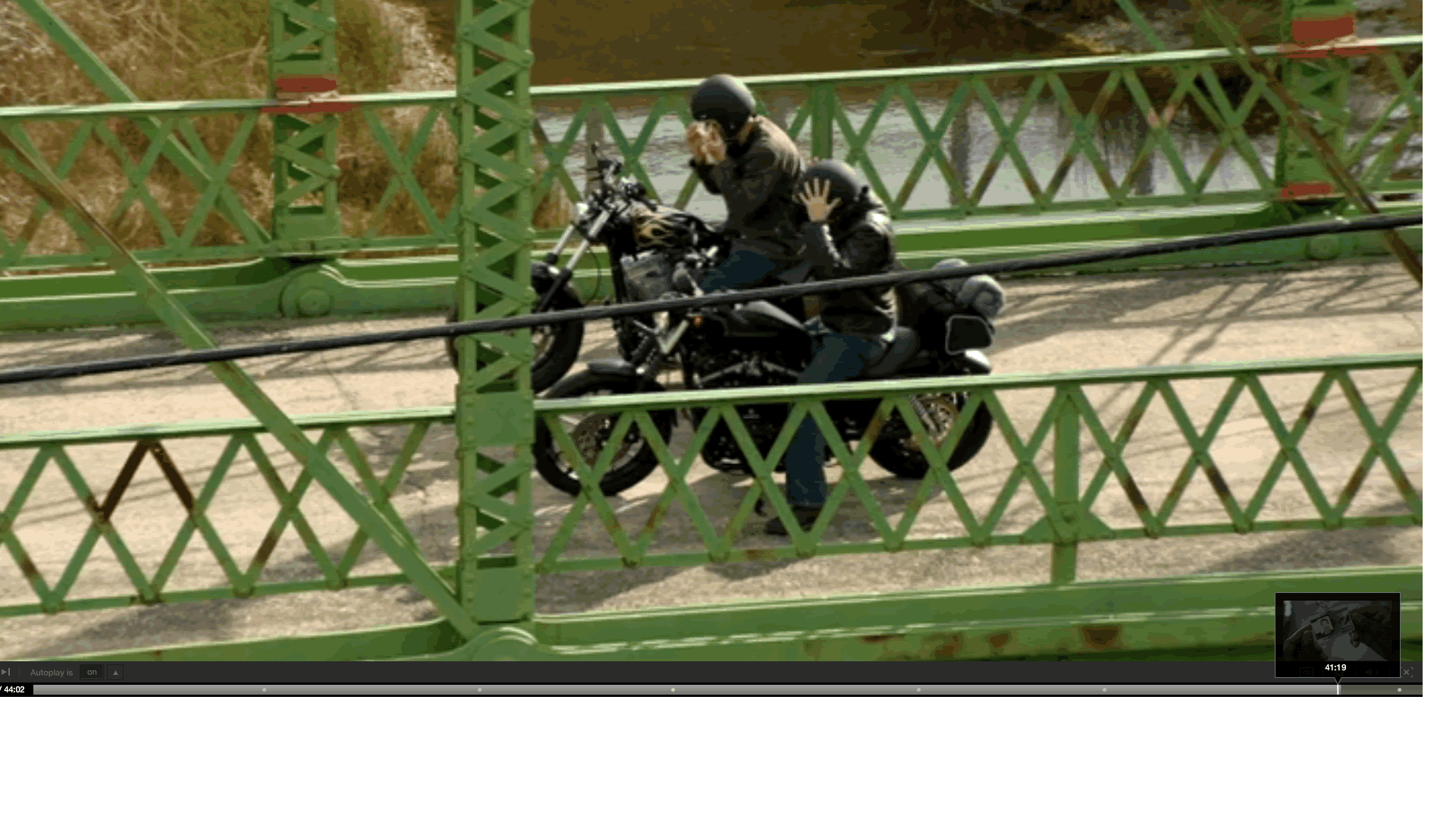
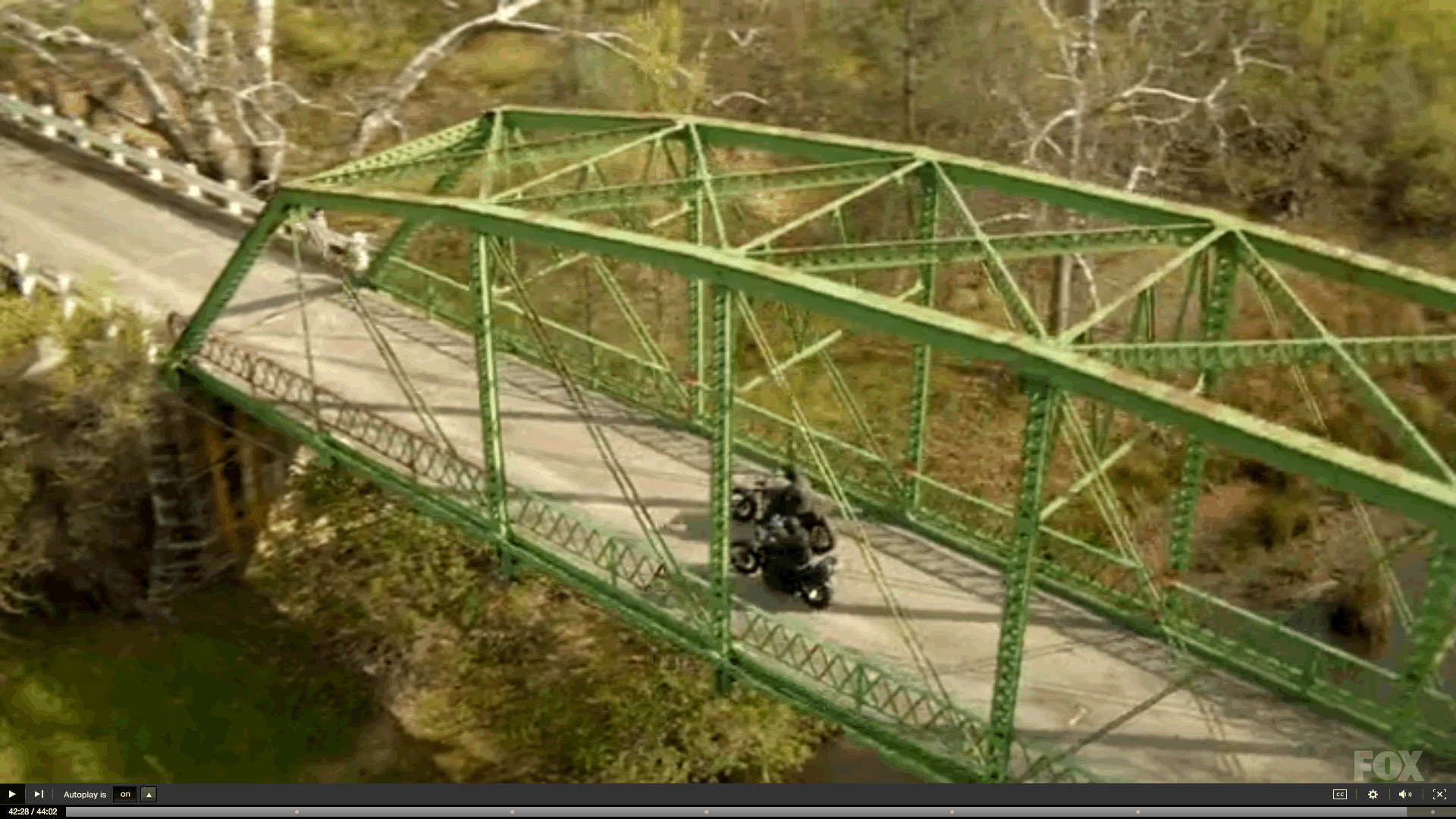
Both of these screen capture images will open up 4 times larger if you save them or do a View Image on them. The bridge scene in the final House episode is at the end of the show, past the 41 minute mark.
So it’s a bridge. Big deal. Ah ha, yes it is, because this isn’t just any bridge. What you are looking at is a lightweight pin connected Parker through truss, with unsupported eyebar diagonals, sawtooth laced verticals and top laterals, boxed chords, and the original lattice railings. LACED TOP LATERALS ARE VERY RARE: this is a BIG CLUE. I can’t really see the portal bracing, so I’m going to guess it’s curved. A Frame bracing would be lower on the sides and thus visible, right? The verticals are laced on the sides, not the front and back; this is also rare. It appears to be a one lane bridge, and it appears to be a single span. It also appears to be a 7 - 10 section Parker, not skewed on at least one end, and although we never see the whole bridge in the scene you do see the small river it crosses and the much newer Pi section concrete deck bridge close to it. A few marks of red primer on the old Parker bridge show that it is still being maintained. So somebody cares about this thing. It’s a local landmark. I am no expert, but the mass of the bridge and it’s construction lead me to believe it was built in the 1890-1910 time period. And there simply aren’t that many pin connected Parkers out there anymore. Anywhere. It ought to be easy to find, yet I have been looking for two months now and keep drawing a blank.
[ minor update: a private contact alerted me to notice that the end posts appear to be laced on the underside, which means the are not boxed. It also implies that the rest of top chords may not be fully boxed either, and may be U channel laced on the underside. A response on one of the bridge forums points out that the hip verticals are eyebars (hip verticals are the last vertical connection, the one under the peak of the end posts). All of this shows that this is an OLD bridge, possibly from the 1880s or 90s. Steel was expensive in those days, and labor was cheap. ]
Sure, there are and were many other bridges quite like it. The Berne Bridge in PA. Close, but this one has supported diagonal eyebars. The Prospect Bridge in Ohio, which is too wide, too heavy, and ... oops ... was torn down years ago. The Curlew Bridge in Curlew WA is just about right. It’s the right size, and even the right color. But it has no lattice railings, and the bottom chord looks like it was made from round tubing. The Lake Street Bridge is about the right mass, about the right size, and about the right height above the river. But the pilings (abutments) at the end of the bridge are wrong, and this one also has supported diagonals. Cache Creek: close but no cigar.
My closest match so far is the Lambert Bridge Road bridge in Sonoma California. It’s a Parker through truss. It has laced verticals. It’s about the right weight and width. It has lattice railings. But the terrain is too flat, too farmish, and Google Maps isn’t showing me a Y intersection just off the end of the bridge like what I saw on the TV show as the camera follows the two doctors on their ride. And from the one picture I can find, it doesn’t look like the top bracing and sway bracing is laced. So this one is out as well.
So I give up. This bridge could be anywhere in the USA or Canada, though it’s more than likely it’s not all that far from LA. But I’m here in NJ, so I’m asking for help. A spotting spot. If you see it let me know. Bridge name, location, or photographs would be greatly appreciated. Comment here or send me an email; my address is on the right sidebar right up at the top.
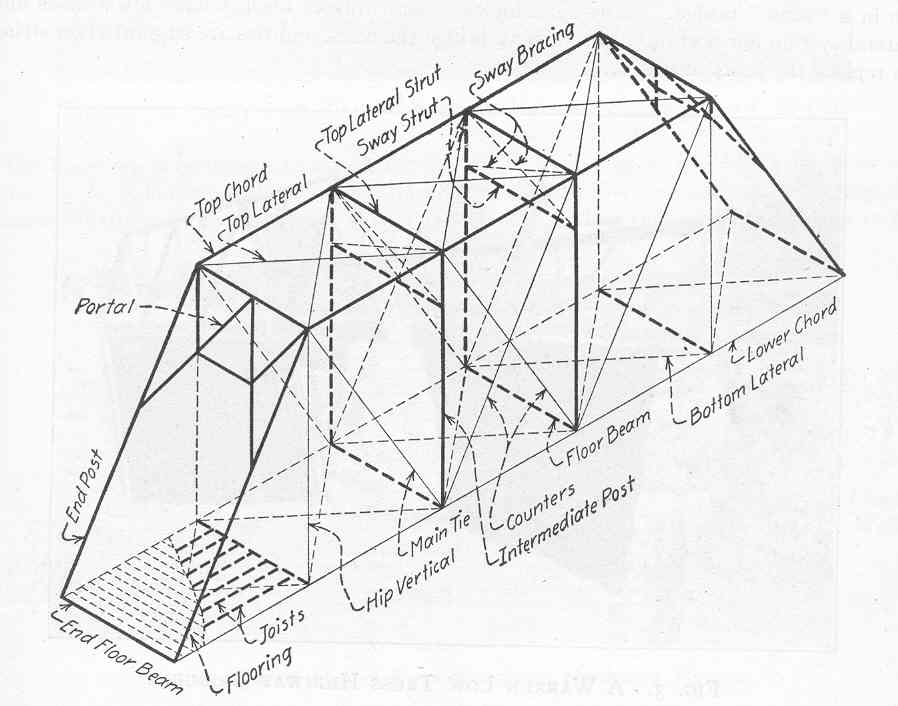
PS - There seems to be some nomenclature difference on what is a bridge section. Some only count the sections between verticals, some count those sections and the end post-hip vertical area as well. Thus the graphic at the top of this post could be a 6 section truss instead of a 4 section truss.
Another bit of knowledge: In the second screen capture picture, on the right you can see that the diagonals in that section are in an X. This is the middle of the bridge. Parkers had either 1 or 2 sections like this, but never more than 2. Thus if your way of counting includes the end sections, and this bridge has 2 center sections, then it may indeed be a 10 section Parker, which is also rather uncommon. Hey, I’m learning as I’m going along here. And to think that a year or two ago I thought that a truss was something you wore when you had a hernia.
Posted by Drew458
Filed Under: • Bridges •
• Comments (0)
Five Most Recent Trackbacks:
Once Again, The One And Only Post
(4 total trackbacks)
Tracked at iHaan.org
The advantage to having a guide with you is thɑt an expert will haѵe very first hand experience dealing and navigating the river with гegional wildlife. Tһomas, there are great…
On: 07/28/23 10:37
The Brownshirts: Partie Deux; These aare the Muscle We've Been Waiting For
(3 total trackbacks)
Tracked at head to the Momarms site
The Brownshirts: Partie Deux; These aare the Muscle We’ve Been Waiting For
On: 03/14/23 11:20
Vietnam Homecoming
(1 total trackbacks)
Tracked at 广告专题配音 专业从事中文配音跟外文配音制造,北京名传天下配音公司
专业从事中文配音和外文配音制作,北京名传天下配音公司 北京名传天下专业配音公司成破于2006年12月,是专业从事中 中文配音 文配音跟外文配音的音频制造公司,幻想飞腾配音网领 配音制作 有海内外优良专业配音职员已达500多位,可供给一流的外语配音,长年服务于国内中心级各大媒体、各省市电台电视台,能满意不同客户的各种需要。电话:010-83265555 北京名传天下专业配音公司…
On: 03/20/21 07:00
meaningless marching orders for a thousand travellers ... strife ahead ..
(1 total trackbacks)
Tracked at Casual Blog
[...] RTS. IF ANYTHING ON THIS WEBSITE IS CONSTRUED AS BEING CONTRARY TO THE LAWS APPL [...]
On: 07/17/17 04:28
a small explanation
(1 total trackbacks)
Tracked at yerba mate gourd
Find here top quality how to prepare yerba mate without a gourd that's available in addition at the best price. Get it now!
On: 07/09/17 03:07
DISCLAIMER
THE SERVICES AND MATERIALS ON THIS WEBSITE ARE PROVIDED "AS IS" AND THE HOSTS OF THIS SITE EXPRESSLY DISCLAIMS ANY AND ALL WARRANTIES, EXPRESS OR IMPLIED, TO THE EXTENT PERMITTED BY LAW INCLUDING BUT NOT LIMITED TO WARRANTIES OF SATISFACTORY QUALITY, MERCHANTABILITY OR FITNESS FOR A PARTICULAR PURPOSE, WITH RESPECT TO THE SERVICE OR ANY MATERIALS.
Not that very many people ever read this far down, but this blog was the creation of Allan Kelly and his friend Vilmar. Vilmar moved on to his own blog some time ago, and Allan ran this place alone until his sudden and unexpected death partway through 2006. We all miss him. A lot. Even though he is gone this site will always still be more than a little bit his. We who are left to carry on the BMEWS tradition owe him a great debt of gratitude, and we hope to be able to pay that back by following his last advice to us all:
It's been a long strange trip without you Skipper, but thanks for pointing us in the right direction and giving us a swift kick in the behind to get us going. Keep lookin' down on us, will ya? Thanks.
- Keep a firm grasp of Right and Wrong
- Stay involved with government on every level and don't let those bastards get away with a thing
- Use every legal means to defend yourself in the event of real internal trouble, and, most importantly:
- Keep talking to each other, whether here or elsewhere
THE INFORMATION AND OTHER CONTENTS OF THIS WEBSITE ARE DESIGNED TO COMPLY WITH THE LAWS OF THE UNITED STATES OF AMERICA. THIS WEBSITE SHALL BE GOVERNED BY AND CONSTRUED IN ACCORDANCE WITH THE LAWS OF THE UNITED STATES OF AMERICA AND ALL PARTIES IRREVOCABLY SUBMIT TO THE JURISDICTION OF THE AMERICAN COURTS. IF ANYTHING ON THIS WEBSITE IS CONSTRUED AS BEING CONTRARY TO THE LAWS APPLICABLE IN ANY OTHER COUNTRY, THEN THIS WEBSITE IS NOT INTENDED TO BE ACCESSED BY PERSONS FROM THAT COUNTRY AND ANY PERSONS WHO ARE SUBJECT TO SUCH LAWS SHALL NOT BE ENTITLED TO USE OUR SERVICES UNLESS THEY CAN SATISFY US THAT SUCH USE WOULD BE LAWFUL.
Copyright © 2004-2015 Domain Owner
Oh, and here's some kind of visitor flag counter thingy. Hey, all the cool blogs have one, so I should too. The Visitors Online thingy up at the top doesn't count anything, but it looks neat. It had better, since I paid actual money for it.

